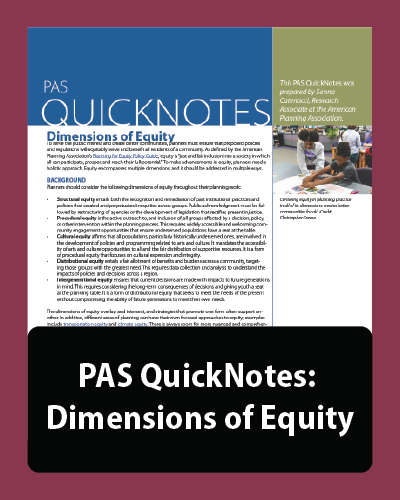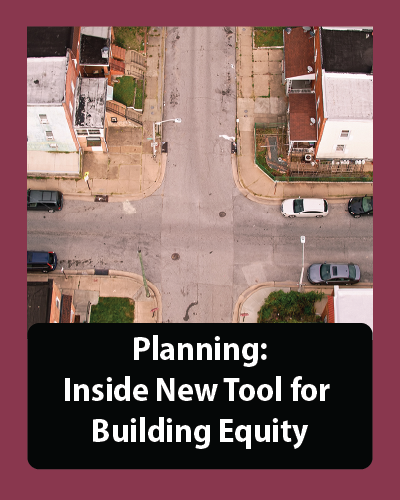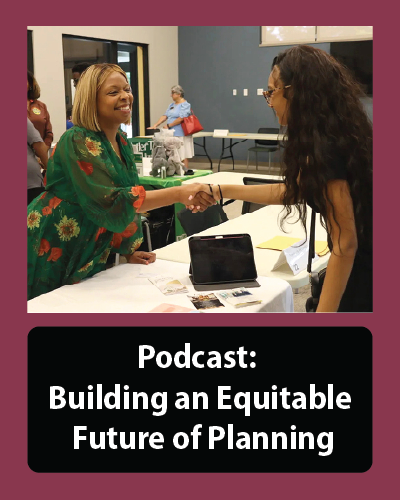Knowledgebase Collection
Social Equity

Adapted from images by storyset on Freepik
The planning profession is motivated by the desire to create better communities, with clean environments, affordable housing, open space, accessible transportation, and good educational opportunities. Planners have helped to create these conditions in many communities, but in many others, certain groups have been systematically excluded. Health, income, mobility, and other inequities are institutionalized in policies and practices that disproportionately limit opportunity and assign a burden to groups based on race, age, gender, sexual orientation, immigration status, religion, or disability. Inequity can be observed when communities are displaced due to gentrification, when communities report higher rates of disease due to the presence of a hazardous waste facility or the absence of healthy food, or when communities are excluded from participating in the planning process due to language or logistical barriers. Planning for social equity means recognizing planning practices that have had a disparate impact on certain communities and actively working with affected residents to create better communities for all.
From this page, you can search for resources that provide background, policy guidance, and examples of local plan recommendations and zoning standards for social equity from across the country. And you can filter these search results by various geographic and demographic characteristics.
Contents
Featured APA Resources
Defining Social Equity
PolicyLink defines equity as “just and fair inclusion into a society in which all can participate, prosper, and reach their full potential. Unlocking the promise of the nation by unleashing the promise in us all.” Unlike equality, which connotes sameness, equity is responsive to difference; equitable policies actively mitigate the disproportionate harm faced by certain communities. Three cross-cutting issues related to social equity in planning include gentrification, environmental justice, and community engagement and empowerment.
While measuring social equity can be difficult, several resources exist to help communities identify and monitor local inequities. These resources describe how to collect and analyze data on equity indicators from sources like the U.S. Census Bureau, the CDC, and the EPA. Quantitative data analysis can begin to expose some of a community’s equity issues, but should be combined with qualitative surveys and interviews to gain a clearer understanding of how inequity is experienced by affected residents.
Social Equity and Ethics
The planning profession has played and continues to play a role in creating and reinforcing inequity. While openly discriminatory practices like redlining are illegal today, many communities are still struggling to recover from generations of targeted exclusion and disinvestment. As they try to recover, they face modern discriminatory practices like exclusionary zoning and the concentration of polluting industries.
The AICP Code of Ethics (2016) calls planners to do better: “We shall seek social justice by working to expand choice and opportunity for all persons, recognizing a special responsibility to plan for the needs of the disadvantaged and to promote racial and economic integration. We shall urge the alteration of policies, institutions, and decisions that oppose such needs.” Planners have an unambiguous ethical responsibility to alleviate inequities and to prioritize the needs of communities that are negatively impacted by historic and contemporary discrimination.
Equity in All Policies
An equity in all policies approach involves using an equity lens in all planning practices, including work on climate change and resilience, economic development, education, energy and resource consumption, public health, heritage preservation, housing, mobility and transportation, and public spaces. Planning for equity does not stifle growth or impede development. Instead, it expands opportunities to all members of a community and builds local capacity to respond to equity concerns moving forward.
An important component of the equity in all policies approach is improving planning processes to facilitate engagement from diverse stakeholders, perhaps through the use of language interpreters or by providing child care services. This requires planners to be cognizant of the power differences among various stakeholders and to advocate for the voices that are often silenced in these conversations. Besides improving the process, the content of plans and policies must also directly address inequities. Public officials can also require developers to complete a Social Impact Assessment (SIA) to improve understanding of the consequences of a project on the surrounding community. Any local strategy to address social equity must be informed by local planning history, the equity landscape, and the input of diverse stakeholders.
Related Collections
Affordable Housing Programs
Since the late 20th century, many communities have created programs to preserve or expand the local supply of affordable housing. This collection catalogs resources that provide background and policy guidance or demonstrate how local and regional agencies are using regulatory, investment, and assistance programs to promote or protect affordable housing.
Age-Friendly Communities
Age-friendly communities are places where the built and social environment is accessible to and inclusive of all residents — young and old. This collection catalogs resources that provide background and policy guidance or demonstrate how cities and counties are using plans, programs, and regulations to foster accessible and inclusive communities.
Biophilic Planning
Biophilic planning seeks to strengthen connections between people and nature. This collection catalogs resources that provide background and policy guidance on biophilic planning and demonstrate how local and regional agencies are using plans, regulations, and programs to promote biophilic principles.
Built Environment and Health
Planning evolved as a response to issues in the built environment, like overcrowding, that contributed to public health crises. This collection catalogs resources that provide background, research, and policy guidance or demonstrate how local and regional agencies are using plans, regulations, and programs to guide change in the built environment to improve health outcomes.
Climate Change
Planners have a responsibility to help shape and implement plans that decrease greenhouse gas (GHG) emissions and protect communities from climate-related hazards. This collection catalogs resources that provide background and policy guidance on climate change and action and demonstrate how local and regional agencies are using plans, programs, and regulations as climate action tools.
Complete Streets
Complete streets is an approach to planning and designing streets and street networks that prioritizes safe and convenient access for all modes and users. This collection catalogs resources that provide background and policy guidance, as well as examples that demonstrate how localities are using plans, policies, and regulations to consider all modes of transportation in the design of streets.
Comprehensive Planning
A comprehensive plan is an official statement that sets forth goals, policies, and guidelines intended to direct a jurisdiction's present and future development. This collection catalogs resources that provide background information, comprehensive plan development guidance, and examples of potentially noteworthy plans from various types of communities across the country.
Hazard Mitigation
Hazard mitigation is any sustained action taken to reduce or eliminate the risk of property damage or injuries from natural or human-caused disasters. This collection catalogs resources that provide background and policy guidance or demonstrate how cities and counties are using plans, programs, and regulations to mitigate natural and human-caused hazard risks.
Inclusionary Housing
Inclusionary housing programs link affordable housing provision to private development by requiring or incentivizing developers to construct affordable housing units as part of market-rate residential projects. This collection catalogs resources that provide background and policy guidance or demonstrate how localities are using plans and development regulations to promote inclusionary housing.
Online Public Engagement
Online public engagement is an umbrella term for public-sector efforts to notify, inform, consult, or collaborate with community members through websites and web applications. This collection catalogs resources that provide background and policy guidance as well as resources that explain or illustrate how local and regional agencies are using online public engagement tools and techniques.
Shared Mobility
Shared Mobility refers to transportation services that provide users with short-term access to transportation modes on an as-needed basis. This collection catalogs resources that provide background and policy guidance or demonstrate how local and regional agencies are taking action to accommodate or encourage ridesourcing; bike, car, and scooter sharing; ridesharing; and microtransit services.
Smart Cities
A “smart city” uses information and communication technology (ICT) to optimize citizen engagement, service delivery, and systems performance. This collection catalogs resources that provide background and policy guidance, as well as examples of local uses of information and communications technology to engage citizens, deliver services, and enhance urban systems.
Urban Heat Resilience
Extreme heat is one of the deadliest climate risks in the United States. This collection summarizes the state of the practice regarding local and regional efforts to mitigate and manage urban heat effects. And it catalogs resources that provide background and policy guidance or demonstrate how local and regional agencies are using plans, programs, and regulations to boost resilience to urban heat.
Zoning Reform and Code Writing
Zoning is among the most powerful tools local governments have to control future land use and development. This collection catalogs resources that provide general background, policy and process guidance, and examples of code evaluation reports and noteworthy recent zoning and development codes from various types of communities across the country.










